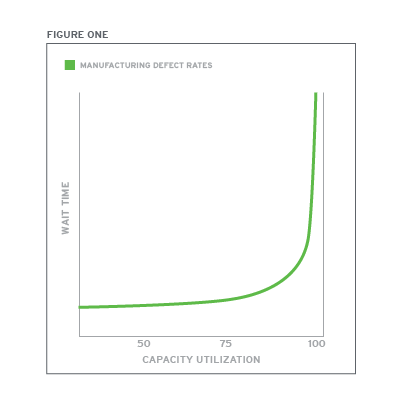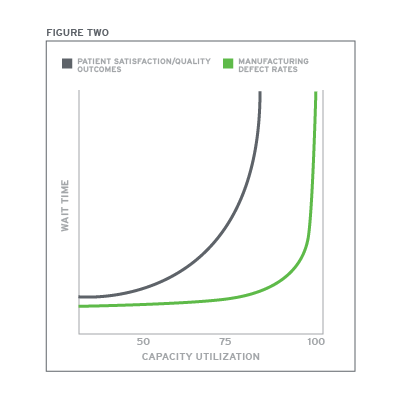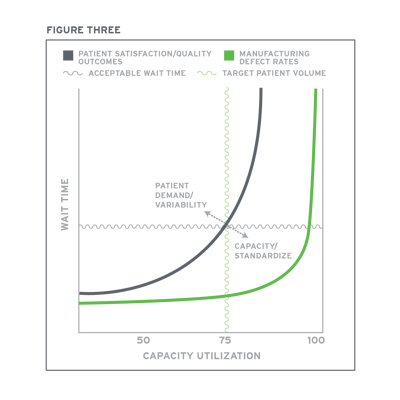The model of supply and demand has been popular in economics for centuries. With the evolving changes in healthcare and government policies, this concept is more relevant to healthcare than ever before. The price of oil is down, in part, because of the glut of supply available on the marketplace. Middle Eastern countries are betting that as prices remain low, newer oil producers in the U.S., who have a higher production cost per barrel than the Mideast, will close their doors. That would reduce supply and competition, and the price of oil would go back up, assuming electric and solar don’t take the country by storm by then.
 Let’s relate this to common healthcare economics. Imagine if census days dropped 30 percent, and unused clinic visits increased by 20 percent. Prices would surely decrease, and organizations would be looking at ways to increase their patient population or face contraction. If healthcare organizations downsized to fewer staff and beds, and suddenly all of the patients returned, what might happen?
Let’s relate this to common healthcare economics. Imagine if census days dropped 30 percent, and unused clinic visits increased by 20 percent. Prices would surely decrease, and organizations would be looking at ways to increase their patient population or face contraction. If healthcare organizations downsized to fewer staff and beds, and suddenly all of the patients returned, what might happen?
It could be hard to scale quickly enough to meet the patient demand, and there could be increased lag time in patients getting in and being seen, leading to increased disease onset, annoyed patients, rushed care, overworked staff, and poor outcomes. There is also a chance that new care models like retail clinics and population health can disrupt the healthcare industry (just like electric and solar are disrupting the energy industry), and significant shifts can occur without enough advanced notice to make changes. While the healthcare industry may not be quite as volatile as energy, there are certainly parallels, and organizations need to understand the dynamics at play and be ready to shift their focus as needed to meet marketplace needs.
As a healthcare leader, it’s your job to understand these economies and keep patients moving through your doors while also managing staffing, productivity, bottom line revenue and market share. You're also concerned with the bottom line and need to manage staffing and productivity while also growing revenue and market share. Balance and informed decisions are critical to success. In reality, there are a lot of interrelated dynamics in healthcare that need to be balanced.
- Patients want to be seen quickly and receive high quality care and positive outcomes.
- Providers want to care for patients, have full schedules, and be respected by their peers.
- Integrated healthcare delivery networks (IDNs) want to grow their patient base, efficiently manage operations and maximize revenue.
These needs and goals can complement each other but do not always come together naturally. If you were to grow your patient base too quickly and outpace provider capacity, that patient base may feel underserved and go elsewhere while providers may feel rushed in their care. If you hired too many physicians and couldn’t fill those appointment slots or keep your beds full, you could overspend on staffing and have unhappy, underused physicians. Strategic planning and alignment can be difficult, but it’s critical to overall success. Applying supply and demand mechanics and queuing theory principles can help us to more easily understand the dynamics at play, support balance measures, and frame improvement opportunities.
What queueing theory might do for you
The variability in patient health needs (demand) and complex dynamics of healthcare relationships can lead to difficulty in predicting and modeling organizational capacity. It’s important to maximize staff and resource usage and efficiency while also growing the patient base and meeting patient needs. To help determine capacity and throughput needs, many groups have found success in applying queueing theory[i] and quantitative statistics, which has been made more popular in healthcare through Lean and Six Sigma methodologies.
Queuing theory in manufacturing
A different type of supply and demand economics plays out in the manufacturing industry. The marketplace sets a certain demand for products to be purchased, and it’s up to companies to meet that demand with resource capacity to produce these products at an acceptable cost while remaining profitable. In manufacturing, queuing theory has been used to determine the ideal schedule and process flow to maximize the amount of machine capacity that can be used (i.e., the number of parts to move through an assembly line in a given period of time) while minimizing product defects or wasted resources. Production continues at a fairly reasonable rate before the wait time and defect rate exponentially increase. This exponential increase, known as Little’s Law, is widely accepted and observed throughout industry.[ii] Manufacturing applies Little’s Law and queuing theory to maximize output, increase quality, reduce defect rates, and manage overall machine capacity.

Queueing theory in healthcare
Queuing theory and Little’s Law can also be applied to healthcare to maximize the number of patients who can be seen while maintaining quality patient outcomes. Where manufacturing is very methodical and predictable, healthcare can vary significantly as patients have many different needs, and care team members have dynamic roles and responsibilities. These additional variables can lead to earlier onset of the inflection point in Little’s Law and exponential decrease in quality outcomes and patient satisfaction.
"Where manufacturing is very methodical and predictable, healthcare can vary significantly as patients have many different needs, and care team members have dynamic roles and responsibilities."
To better understand the application of queuing theory in healthcare, a simple translation can help:
- Wait time = the amount of time a patient must wait for an appointment, delays in care, wait times in an ER
- Capacity utilization = total number of provider visits, ER or IP beds (organization capacity)
- Defect rates = patient satisfaction, quality outcomes

Strategic understanding
Successful application of queuing theory and Little’s Law can help organizations grow strategically while increasing revenue and reputation. To support organizational growth, healthcare leaders should manage the inflection point and find the right balance between the growth of their patient base (patient demand) and the overall capacity of the organization (supply). To support this growth, it can be useful to set targets for
- Acceptable patient wait times, appointment lag times, or patient satisfaction thresholds
- Target number of patients to care for across clinics, hospitals, ERs, ORs, and other facilities
Increasing patient demand for care will increase the variation between patient care events and needs, causing the slope of the inflection point to be more severe and occur more rapidly if countermeasures are not made to increase capacity. Conversely, standardizing operational processes and using technology to automate processes can help reduce the slope of the line and shift the inflection point down. Increasing overall capacity by maximizing available visits or beds can shift the inflection point right.

Increasing demand for services and organization capacity to provide services are constantly shifting. It’s necessary to establish a target baseline for the number of patients to be seen, as well as acceptable wait time and quality outcome scores. Identifying the point at which patient satisfaction and demand is negatively impacted is key to this process.
Right-sizing patient demand and service-line capacity
To effectively balance patient demand and capacity, it’s necessary to keep a watchful eye on key metrics related to current clinic and hospital utilization, as well as anticipated demand by new and returning patients. Organizations can set targets for the expected number of patients to care for and establish and measure target wait times. Through routine data collection and data analytics, it’s possible to complete studies of current usage to help predict patient service needs. Analytic tools can also help you understand probabilities of increasing patient demand based on geographic reach, population characteristics such as age and gender, practice guidelines by condition, and more. In understanding service line capacity, it’s important to differentiate between a temporary patient backlog and an increasing overall demand to match operational efforts to the actual need. As the patient base grows, capacity is increased, and processes are standardized, it’s important to keep a pulse on overall staff satisfaction and productivity through EHR reporting, user surveys, and observation. As improvements and adjustments are made, this data-informed approach is critical to monitor and inform future changes, initiatives, and projects across the organization including growing referrals, standardizing patient access and clinical care, and improving patient outcomes and retention.
In conclusion
The concept of supply and demand applied to your healthcare organization can lead to strategic growth while increasing revenue and improving your reputation. The overarching challenge is the delicate balance between increasing capacity and increasing demand. If you'd like to discuss further, please contact us. Thanks for reading.
[i] http://web.mit.edu/sgraves/www/papers/Little's%20Law-Published.pdf
[ii] http://www.ncbi.nlm.nih.gov/pubmed/15114227






